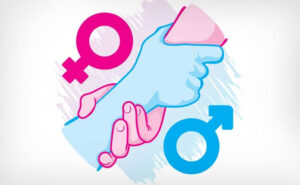Introduction
LGBTQ+ is a term which stands for lesbian, gay, bisexual, transgender, and queer community. LGBTQ+ represents a spectrum of gender identities and sexual orientations beyond just male and female, acknowledging non-binary, genderqueer, and other identities. LGBTQ people perceive different gender identities, which must be respected and appreciated for an inclusive society.
The ‘+’ in LGBTQ+ represents people who are part of the community apart from the people who are LGBTQ. The term LGBT was first used in June 1969 during the Stonewall riots but it became famous in late 20th century. Earlier, this community was unrecognised but after many initiatives by this community, such as Stonewall riots, LGBTQ+ Movement, pride movement and others, this term became famous worldwide. People all over the world understood about other identities which were different from male and female. Various people started recognising and accepting their identity. This helped in engaging a greater number of people in this movement, making this movement famous worldwide.
The symbol of this movement is a rainbow flag. The members of LGBTQ+ are still fighting for the recognition of their rights.
What does each letter in LGBTQ mean?
- L: (lesbian) – a lesbian is a woman who is sexually, emotionally, and romantically attracted to Other women.
- G: ( gay) – a gay is a man who is sexually, emotionally, and romantically attracted to Other men.
- B: (bisexual) – a bisexual is a person who is attracted sexually, emotionally and romantically to more than one gender.
- T :(transgender) – a person whose gender identity differs from the sex they were assigned at birth.
- Q ( queer ) – queer is an umbrella term used for people who are exploring their sexual orientation or gender identity.
Terminologies: gender identity, sexual orientation, and sex
Gender identity is a person’s deeply felt a sense of being a male or a female. It may expand from the categories of man and woman. It may or may not be similar to the sex assigned at birth.
Sexual orientation refers to a person’s emotional, sexual, and romantic feeling with person of same or different sexes. Like, Asexual people experience little or no sexual orientation.
Sex is a biological term, which means that a person’s gender is assigned through their genital at birth.
Traditional/stereotype belief
The traditional system of India considers only two gender-male and female. Earlier there was no recognition of other gender. After various movements, India recognised transgender. In 2014, the Supreme Court gave the transgender community the right to be called the third gender in the NALSA judgement. However, still the society feels threatened. If any gender does not follow the established behaviours set by the society based on their gender, it harms the morals of the society.
For example, the basic mindset of society is – women are always considered submissive, doing household chores. Men are considered as assertive, bossy, and breadwinner of the family. The people who differ from the binary spectrum of expected gender behaviour remained largely invisible and unrecognised because of the fear of stereotypical mindset of the society and lack of information.
Rights of LGBTQ+
LGBTQ+ community is subject to the same laws and orders as well as enjoy the same rights as other citizens of the country. However, in real life they face discrimination and violence by the people for just being who they are. They are not allowed to live a dignified life. Healthcare services are often not provided to them.
They are often disregarded in the society. International human right laws recognise the rights of the LGBTQ people and takes various measures in safeguarding their rights. Yet, many countries laws are against the LGBTQ people and still hasn’t recognised this community. 60 countries criminalise same sex relationships. India is one of those countries which is against the same sex marriage. However, India has decriminalised Article 377, which criminalised homosexuality between consenting adults in the year 2018 as it was against the principle of equality, liberty, dignity under Article 14, 19 and 21.
Section 377
Section 377 of the IPC says that “whoever voluntarily has intercourse against the order of nature, with any man, woman, or animal, shall be punished with imprisonment for life, or with imprisonment, which may extend to 10 years with fine.”
This section was established by the Britishers in the year 1861, which was effective in India even after independence, which criminalised consensual homosexuality between the two adults.
In the year 2016, Navtej Singh Johar filed a writ petition to the Supreme Court of India challenging the constitutionality of section 377.
Moreover, under article 21, the petition also demanded recognition of the right to sexuality, sexual autonomy and the right to choose sexual partner of their own choice guaranteed by the Constitution. The petitioner demanded the recognition of all sexual orientation.
Judgement
The judgment was delivered by a five-judge bench. They accepted the fact that Article 377 violated the rights of LGBTQ community and also observed that section 377 promoted discrimination on the basis of different sexual identity. Considering the supremacy of the fundamental rights- Article 14(right to equality), Article 15 (abolition of discrimination), Article 19 (right to freedom) and Article 21(right to life and liberty). The judges unanimously held section 377 to be unconstitutional. However, the court clarified that consent must be free, voluntary and devoid of any force or coercion.
Views of Supreme Court on same marriage
The Supreme Court upholds the constitutionality of Special Marriage Act.
The judgement was delivered on October 2023 by 5 sitting judge of Supreme Court.
The Supreme Court followed the majority views. It was held that non-heterosexual couples cannot claim the right to marry each other because there is no fundamental right that allows same sex marriage. Out of five, two judges, namely chief Justice DY Chandrachud and chief Justice Sanjay Kishan supported the same sex marriage rule for establishing an inclusive society and upholding Article 15.
However, the majority views of justices held that there is no legal provision to recognise and grant legal status to non-heterosexual relationships. It was in the realm of the legislature to amend or improve the Special Marriage Act of 1954 to bring same sex marriage in India.







